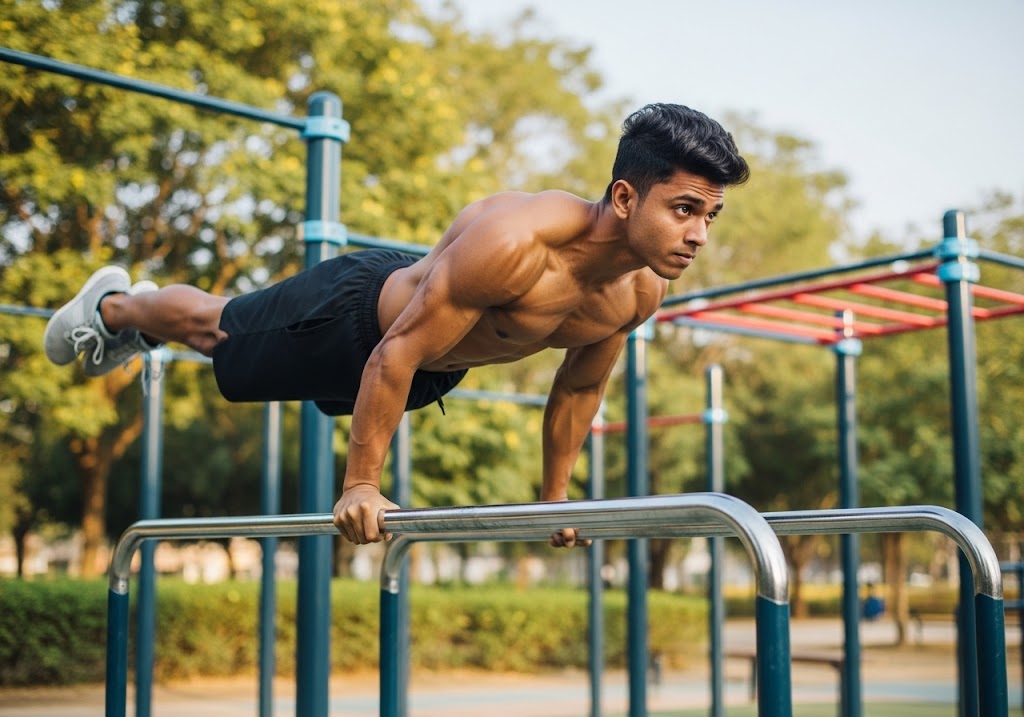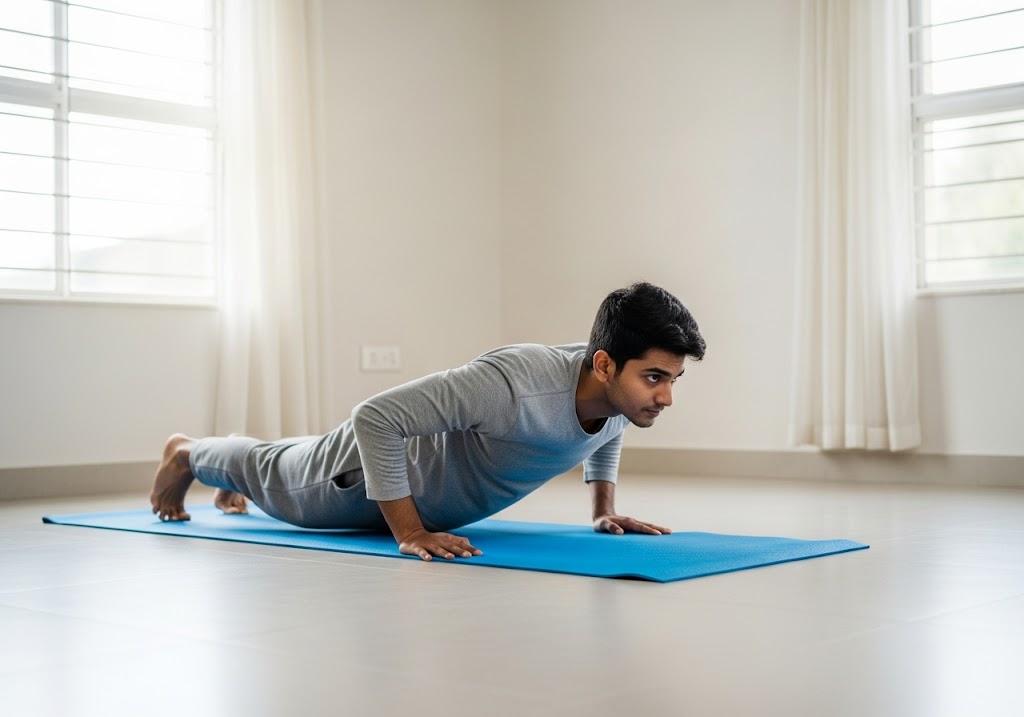How to do jump squats involves squatting down with feet shoulder-width apart, then explosively jumping up while extending your arms overhead, and landing softly back into the squat position.
Learning how to do jump squats properly transforms your fitness routine by combining strength training with explosive power development. This dynamic plyometric exercise targets multiple muscle groups while boosting cardiovascular endurance. Whether you’re an athlete seeking improved performance or someone wanting to build lower body strength, mastering how to do jump squats opens doors to enhanced fitness levels.
Jump squats take traditional squats to the next level by adding an explosive jumping element. This movement recruits fast-twitch muscle fibers, builds functional strength, and improves athletic performance. Understanding how to do jump squats correctly ensures maximum benefits while minimizing injury risk. The exercise requires no equipment, making it perfect for home workouts or gym sessions.
Table of Contents
What Are Jump Squats?
Jump squats represent a plyometric variation of traditional squats that combines strength training with explosive movement patterns. Understanding what jump squats entail helps you appreciate why learning how to do jump squats properly becomes crucial for athletic development and overall fitness improvement.
| Aspect | Description |
|---|---|
| Exercise Type | Plyometric compound movement |
| Primary Focus | Explosive power and lower body strength |
| Equipment Needed | None (bodyweight exercise) |
| Difficulty Level | Beginner to intermediate |
| Movement Pattern | Squat down, jump up, land softly |
| Duration | High intensity, short bursts |
Jump squats combine the stability and strength requirements of regular squats with the explosive power needed for vertical jumping. This exercise teaches your muscles to generate maximum force in minimal time, making it invaluable for athletic performance. When you learn how to do jump squats correctly, you develop the ability to produce rapid, powerful movements that transfer to sports and daily activities.
The explosive nature of jump squats makes them significantly different from regular squats. While traditional squats focus on controlled movement and muscle building, learning how to do jump squats emphasizes speed, power, and cardiovascular conditioning. This difference makes jump squats particularly effective for athletes, fitness enthusiasts, and anyone seeking to improve their functional movement capabilities.
Check out our calisthenics equipment for home to enhance your plyometric training setup.
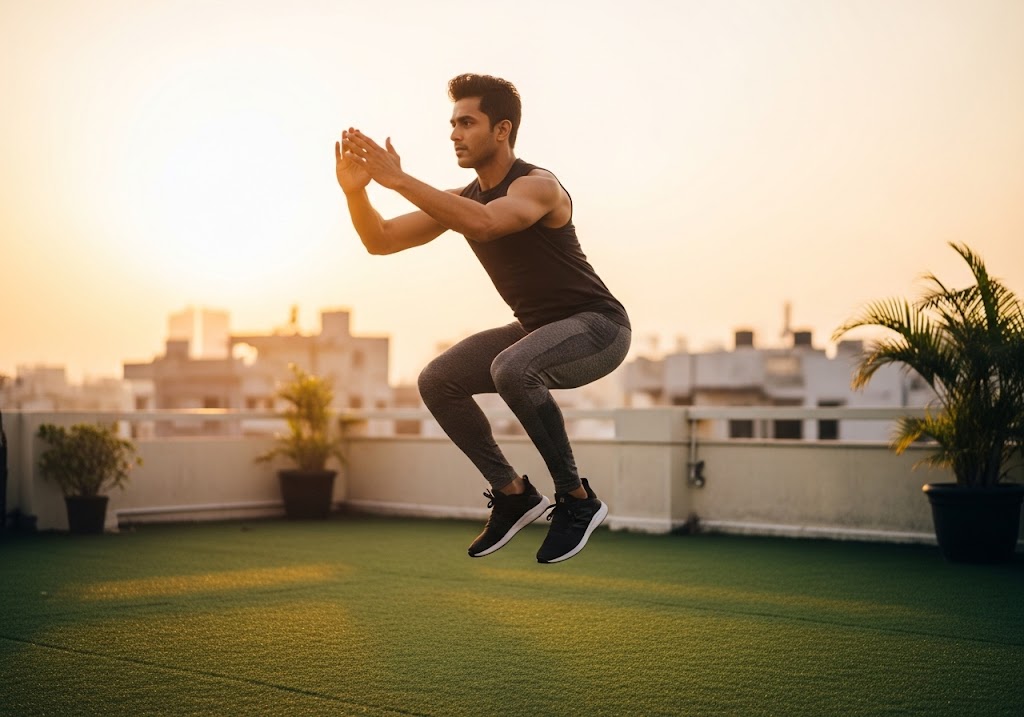
How to Do Jump Squats?
Mastering the proper technique for how to do jump squats requires understanding each phase of the movement. This step-by-step approach ensures you develop correct form while maximizing the benefits of this explosive exercise for strength and power development.
| Step | Action | Key Points |
|---|---|---|
| Starting Position | Stand feet shoulder-width apart | Toes slightly outward, chest up |
| Descent | Lower into squat position | Hips back, knees behind toes |
| Bottom Position | Reach parallel or below | Maintain straight back, engaged core |
| Jump Phase | Explode upward powerfully | Drive through heels, extend fully |
| Air Time | Extend body fully | Reach arms overhead |
| Landing | Land softly on balls of feet | Bend knees to absorb impact |
| Recovery | Return to starting position | Control descent, prepare for next rep |
Check out how many burpees a day to compare different plyometric exercise benchmarks and training volumes.
Starting Position Setup
Proper setup determines your success when learning how to do jump squats effectively. Your foundation must be stable and balanced to generate maximum power while maintaining control throughout the explosive movement pattern. Stand with your feet positioned shoulder-width apart, toes pointing slightly outward for optimal stability. Keep your chest lifted, shoulders back, and core engaged to maintain proper spinal alignment. Your arms should hang naturally at your sides, ready to assist with momentum during the jumping phase of the movement.
Descent and Bottom Position
The lowering phase when learning how to do jump squats requires controlled movement and proper positioning. This phase sets you up for the explosive jumping motion that follows, making it crucial for overall exercise effectiveness. Begin the descent by pushing your hips back and bending your knees as if sitting into an imaginary chair. Lower yourself until your thighs reach parallel to the floor or slightly below, depending on your mobility. Keep your weight distributed evenly across your feet, with slight emphasis on your heels for optimal power generation.
Discover arm workouts with dumbbells women’s to create balanced full-body training routines alongside your explosive leg exercises.
Explosive Jump Execution
The jumping phase represents the most critical aspect when mastering how to do jump squats properly. This explosive movement requires maximum effort and coordination to achieve optimal results while maintaining safety throughout the exercise. From the bottom position, drive explosively through your heels and balls of your feet to propel yourself vertically. Extend your hips, knees, and ankles simultaneously in a powerful, coordinated movement. Allow your arms to swing naturally overhead to assist with momentum and balance during the jump phase. Land softly on the balls of your feet with knees slightly bent to absorb the impact forces. Immediately transition back into the squat position to begin your next repetition. Focus on maintaining control throughout the landing to prevent injury and maintain exercise effectiveness.
Explore our how to do glute bridge to complement your lower body power development.
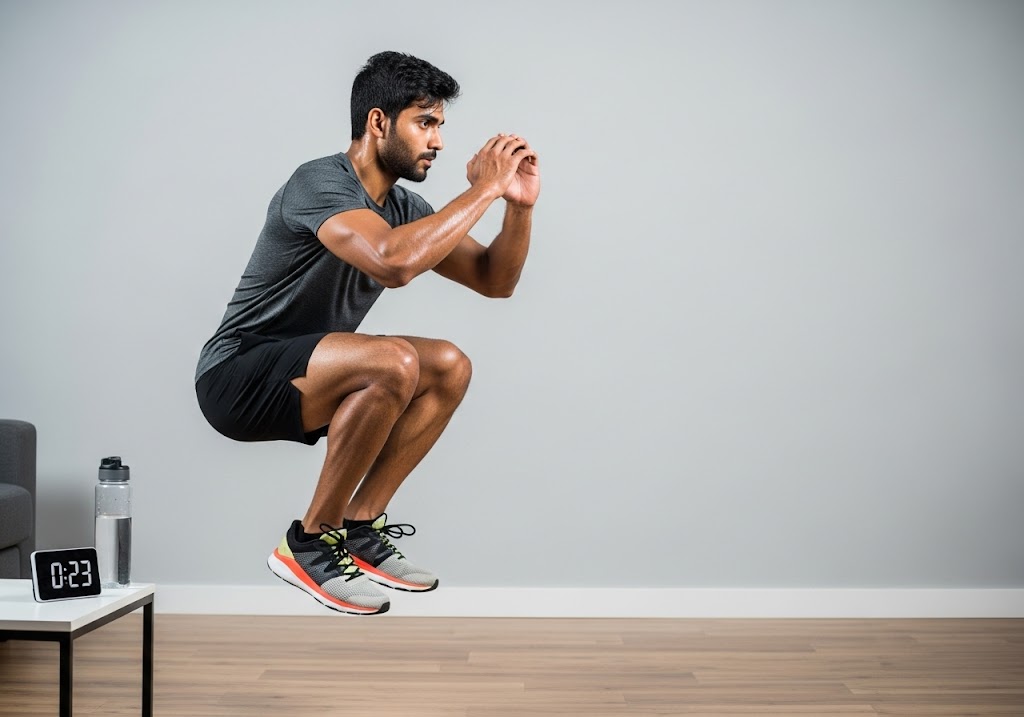
What Muscles Do Jump Squats Work?
Understanding the muscles involved when you learn how to do jump squats helps optimize your training approach and ensures balanced development. This powerful exercise activates multiple muscle groups simultaneously, making it highly efficient for building functional strength and power throughout your body.
| Muscle Group | Primary Function | Activation Level |
|---|---|---|
| Quadriceps | Knee extension during jump phase | Very High |
| Glutes | Hip extension and power generation | Very High |
| Hamstrings | Hip extension and landing absorption | High |
| Calves | Ankle extension and propulsion | High |
| Core Muscles | Stability and posture control | Medium-High |
| Hip Flexors | Hip flexion during jump | Medium |
| Lower Back | Spinal stability | Medium |
The quadriceps muscles serve as the primary drivers when you learn how to do jump squats effectively. These four muscles on the front of your thighs work together to extend your knees during the explosive upward phase. The glutes, being your body’s largest muscle group, provide the main power source for the jumping motion while controlling hip extension throughout the movement.
Your hamstrings and calves play crucial supporting roles when you master how to do jump squats properly. The hamstrings help with hip extension and absorption of landing forces, while your calves provide the final push-off power through ankle extension. Core muscles remain constantly engaged to maintain proper posture and stability throughout the entire movement pattern, making jump squats an excellent total-body exercise.
Learn more about how to do plank exercise to strengthen your core for better jump squat performance.

Jump Squat Adaptations
Modifying how to do jump squats allows you to adjust the exercise difficulty and target specific fitness goals. These adaptations help beginners progress safely while providing advanced athletes with greater challenges to continue their development and strength gains.
Beginner Modifications
Starting with proper progressions when learning how to do jump squats ensures safe skill development and builds confidence. These modifications reduce impact and complexity while maintaining the essential movement patterns and training benefits.
- Box Step-Ups – Step onto a stable platform instead of jumping to build leg strength and coordination
- Assisted Jump Squats – Use resistance bands or hold onto a stable surface for balance support
- Shallow Range Squats – Reduce squat depth to quarter-squats while focusing on proper jumping technique
- Slower Tempo – Perform each repetition more slowly to emphasize control and form development
Learn more about resistance band exercises for abs to enhance your core stability for better jump squat performance.
Jump Squats Advanced Variations
Progressive overload when mastering how to do jump squats involves increasing difficulty through various challenging modifications. These advanced variations enhance power development, coordination, and overall athletic performance for experienced practitioners seeking to maximize their explosive training adaptations and strength gains.
| Variation | Difficulty Level | Primary Focus |
|---|---|---|
| Weighted Jump Squats | High | Increased resistance training |
| Single-Leg Jump Squats | Very High | Unilateral strength and balance |
| Tuck Jump Squats | High | Explosive power and coordination |
| 180-Degree Turn Squats | Medium-High | Rotational power and agility |
| Box Jump Squats | High | Vertical jumping and precision |
1. Weighted Jump Squats
Adding external resistance when learning how to do jump squats creates greater overload for strength and power development. This advanced variation challenges your muscles with additional weight while maintaining the explosive movement pattern, making it excellent for experienced athletes seeking increased training intensity.
How to Do Weighted Jump Squats?
- Hold dumbbells (2-10 kg) at your sides or wear a weighted vest
- Maintain proper jump squat form despite added resistance
- Start with lighter weights to master the movement pattern
- Focus on explosive upward movement against increased load
- Land softly with controlled descent to protect joints
- Reduce repetitions initially due to increased difficulty
Check out chest and tricep workout with dumbbells to balance your lower body jump squat training with upper body strength development.
2. Single-Leg Jump Squats
Unilateral training when practicing how to do jump squats challenges balance, coordination, and individual leg strength. This highly advanced variation exposes strength imbalances while developing single-leg power that transfers excellently to sports performance and functional movement patterns requiring unilateral strength.
How to Do Single-Leg Jump Squats?
- Stand on one leg with the other leg slightly lifted behind you
- Perform the squat descent on the working leg only
- Drive explosively upward using only the planted leg
- Land softly on the same leg with controlled absorption
- Maintain balance throughout the entire movement sequence
- Complete equal repetitions on both legs for balanced development
Explore calisthenics chest exercises to develop upper body power that complements your lower body explosive training.
3. Tuck Jump Squats
Combining knee drive with explosive jumping when mastering how to do jump squats maximizes vertical power output. This challenging variation requires exceptional coordination and explosive strength as you bring your knees toward your chest during the airborne phase, significantly increasing the difficulty level.
How to Do Tuck Jump Squats?
- Begin in standard jump squat starting position
- Explode upward with maximum force and height
- Drive knees up toward chest during the jump phase
- Extend legs quickly to prepare for landing
- Land softly in squat position with controlled descent
- Focus on speed and coordination throughout the movement
4. 180-Degree Turn Squats
Adding rotational elements when learning how to do jump squats develops multidirectional power and agility. This variation challenges your spatial awareness and coordination while building rotational strength that transfers to sports requiring quick direction changes and explosive rotational movements for athletic performance.
How to Do 180-Degree Turn Squats?
- Start in standard jump squat position facing forward
- Explode upward while initiating 180-degree rotation
- Turn completely around during the airborne phase
- Land facing the opposite direction in squat position
- Alternate rotation directions with each repetition
- Maintain control and balance throughout the rotational movement
Explore how to do jumping jacks to add variety to your cardiovascular and coordination training routine.
5. Box Jump Squats
Combining vertical jumping with precision landing when practicing how to do jump squats creates functional power development. This variation requires accurate distance and height judgment while building explosive strength, making it excellent for athletic performance and developing confidence in jumping movements.
How to Do Box Jump Squats?
- Position a stable box (30-60 cm height) in front of you
- Perform jump squat movement aiming for box landing
- Land softly on top of box with both feet simultaneously
- Step down carefully rather than jumping down
- Progress box height gradually as strength improves
- Focus on soft landing technique to protect joints
Discover how to lift heavier weights to complement your strength development alongside plyometric training.
Surface and Equipment Jump Squats Variations
Environmental modifications when practicing how to do jump squats can enhance specific training outcomes. Different surfaces and equipment additions challenge your stability, coordination, and power production in unique ways that complement traditional training methods for optimal development.
- Surface and Equipment Variations – Use grass, rubber mats, or bounce surfaces to reduce joint impact and enhance stability training
- Resistance Band Assistance – Use bands attached overhead for partial bodyweight support during learning phase
- Bosu Ball Squats – Add balance challenge by standing on unstable surface during movement
Check out how to do glute bridge to develop posterior chain strength that complements your explosive jumping power.
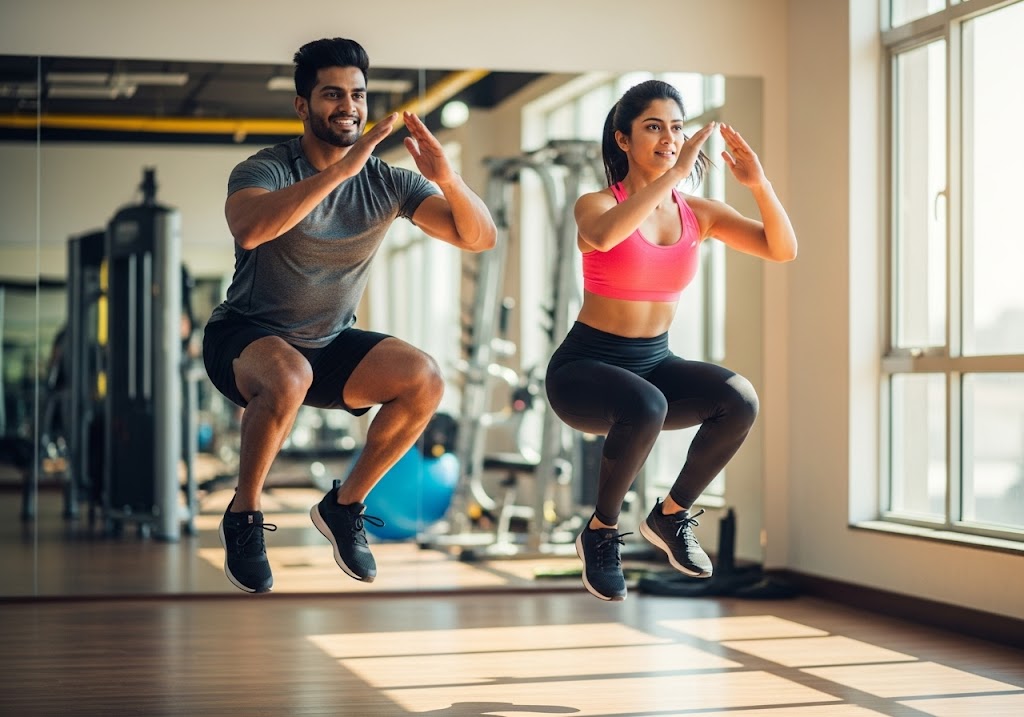
Benefits of Jump Squats
Understanding the advantages of learning how to do jump squats motivates consistent practice and helps you appreciate this exercise’s impact on overall fitness. These benefits extend beyond simple muscle building to include functional movement improvements and athletic performance enhancement.
Regular practice of how to do jump squats delivers multiple physiological and performance benefits that enhance your overall fitness level:
- Explosive Power Development – Trains fast-twitch muscle fibers for improved athletic performance and functional movement
- Enhanced Lower Body Strength – Builds significant strength in quadriceps, glutes, hamstrings, and calves simultaneously
- Improved Cardiovascular Fitness – Elevates heart rate quickly, providing excellent cardiovascular conditioning benefits
- Better Bone Density – High-impact nature stimulates bone formation and helps prevent osteoporosis
- Increased Calorie Burn – Burns 8-12 calories per minute due to high-intensity, full-body muscle engagement
- Enhanced Athletic Performance – Improves vertical jump height, sprint speed, and overall sports performance
- Better Balance and Coordination – Challenges proprioception and neuromuscular control for improved movement quality
- Functional Movement Patterns – Develops strength and power in movement patterns used in daily activities
- Time-Efficient Training – Provides maximum results in minimal time through compound movement efficiency
- No Equipment Required – Perfect for home workouts, travel, or limited space training situations
The compound nature of learning how to do jump squats makes them incredibly efficient for busy individuals. This single exercise targets multiple fitness components simultaneously, including strength, power, coordination, and cardiovascular endurance, making it an excellent choice for time-conscious fitness enthusiasts who want to maximize their training results.
Check out how to burn 400 calories a day to incorporate jump squats into your calorie-burning routine effectively.
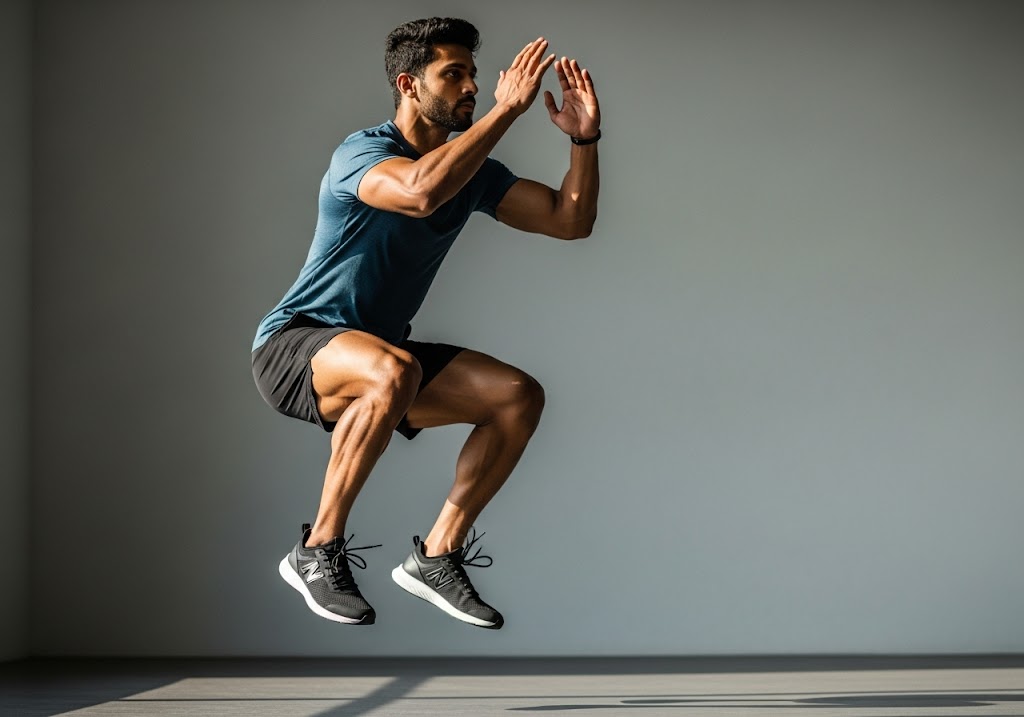
Jump Squat Mistakes to Avoid
Recognizing common errors when learning how to do jump squats prevents injuries and ensures optimal training results. These mistakes can limit your progress and increase injury risk, making proper technique awareness crucial for safe and effective exercise execution.
Avoiding these frequent mistakes when practicing how to do jump squats ensures safer training and better results:
- Inadequate Warm-Up – Never begin jump squats without proper dynamic warm-up to prepare joints and muscles
- Hard Surface Landing – Avoid concrete or very hard surfaces that increase joint impact and injury risk
- Knee Cave Inward – Keep knees aligned with toes throughout the movement to prevent knee strain
- Excessive Forward Lean – Maintain upright torso position to avoid unnecessary stress on lower back
- Incomplete Range of Motion – Avoid partial squats that reduce exercise effectiveness and muscle activation
- Poor Landing Mechanics – Land softly on balls of feet with bent knees rather than stiff-legged impact
- Too Much Too Soon – Progress gradually in volume and intensity to prevent overuse injuries
- Ignoring Pain Signals – Stop immediately if experiencing joint pain or unusual discomfort during exercise
- Improper Breathing – Coordinate breathing pattern with movement rather than holding breath throughout
- Rushing Between Reps – Allow adequate recovery between repetitions to maintain proper form and power output
The most critical mistake when learning how to do jump squats is attempting advanced variations before mastering basic technique. Building a solid foundation with proper form ensures long-term success and prevents the development of compensatory movement patterns that can lead to injury over time when you progress in your jump squat journey.
Poor landing technique represents another significant concern when practicing how to do jump squats incorrectly. Landing with straight legs or excessive forward lean places unnecessary stress on your knees and lower back, potentially causing acute or chronic injuries that could have been prevented with proper instruction and gradual progression.
Learn about how many jumping jacks to burn 500 calories to understand calorie burn rates for different plyometric exercises. Discover jumping jacks exercise benefits to add variety to your plyometric training routine.

Jump Squats: Proper Programming and Progression
Developing an effective training plan for how to do jump squats requires strategic approach to volume, intensity, and progression. Proper programming ensures continuous improvement while preventing overtraining and injury, allowing you to maximize the explosive power and strength benefits of this dynamic plyometric exercise.
Jump Squats: Training Frequency and Volume
Strategic programming when learning how to do jump squats ensures optimal adaptation while preventing overtraining. Proper frequency and volume management allows your body to recover and adapt to the high-intensity demands of plyometric training.
Most individuals benefit from performing jump squats 2-3 times per week with at least 48 hours between sessions. Begin with 2-3 sets of 5-8 repetitions, focusing on perfect form rather than high volume. As you master how to do jump squats properly, gradually increase to 3-4 sets of 10-15 repetitions based on your fitness level and recovery capacity.
Explore calisthenics workout plan to see how jump squats fit into structured bodyweight training programs.
Jump Squats: Progression Strategies
Systematic progression when mastering how to do jump squats prevents plateaus and ensures continuous improvement. These progression methods challenge your body in different ways while maintaining the fundamental movement patterns and safety considerations throughout your training journey.
Progress your jump squat training by first increasing repetitions within each set, then adding additional sets, and finally incorporating advanced variations. Monitor your recovery between sessions and adjust volume accordingly. Quality always takes precedence over quantity when developing explosive power through proper jump squat technique.
Learn about calisthenics for triceps to build comprehensive upper body strength alongside your explosive leg training.
Jump Squats: Safety Considerations and Contraindications
Understanding safety protocols when learning how to do jump squats protects your joints and prevents injuries during high-impact plyometric training. These considerations help identify risk factors, proper precautions, and when to avoid or modify this explosive exercise for optimal training safety and effectiveness.
Who Should Avoid Jump Squats?
Certain individuals should exercise caution or avoid learning how to do jump squats due to increased injury risk. Understanding these contraindications ensures safe participation and helps identify when alternative exercises might be more appropriate for specific circumstances. People with knee, hip, or ankle injuries should avoid jump squats until cleared by healthcare professionals. Those with osteoporosis, recent surgeries, or balance disorders should also seek medical approval before beginning high-impact plyometric training. Beginners should master basic squatting patterns before progressing to explosive movements.
Discover how to do arnold press to add effective shoulder training to your overall fitness routine.
Jump Squats: Injury Prevention Strategies
Implementing proper safety measures when learning how to do jump squats significantly reduces injury risk while maximizing training benefits. These prevention strategies focus on preparation, technique, and recovery to ensure long-term training success and physical wellbeing.
Always begin with thorough dynamic warm-ups including leg swings, bodyweight squats, and light cardio before attempting jump squats. Choose appropriate surfaces, wear proper footwear, and progress gradually in intensity and volume. Listen to your body and avoid training through pain or excessive fatigue that compromises movement quality when you learn how to do jump squats safely.
Check out does calisthenics increase height to understand the broader benefits of bodyweight training methods.
Incorporating Jump Squats into Your Routine
Strategic integration of how to do jump squats into existing workout programs maximizes their effectiveness while complementing other training goals. Proper placement and timing ensure optimal performance benefits without compromising recovery or interfering with other exercise modalities in your fitness routine.
HIIT and Circuit Training
Jump squats excel when integrated into high-intensity interval training protocols. Their explosive nature makes them perfect for circuit training where you need exercises that quickly elevate heart rate while building strength and power simultaneously.
Include jump squats in 30-45 second work intervals followed by 15-30 seconds of rest. Combine them with other bodyweight exercises like push-ups, burpees, and mountain climbers for effective full-body conditioning circuits. This approach maximizes calorie burn while developing multiple fitness components in single training sessions when you consistently practice how to do jump squats.
Learn about jumping jacks exercise benefits to add more plyometric variety to your HIIT routines.
Strength Training Integration
When learning how to do jump squats as part of strength training routines, timing and placement become crucial factors for optimal results. These explosive movements work best when performed while your nervous system is fresh and your muscles haven’t been pre-fatigued by heavy resistance exercises.
Perform jump squats at the beginning of leg workouts as dynamic warm-ups or power development exercises. Alternatively, use them as finishing movements to challenge muscular endurance after completing your primary strength exercises. Avoid performing them immediately before or after heavy squatting movements to prevent technique breakdown.
Check out hack squat vs leg press to understand different lower body strength training options that complement jump squat training. Explore our calisthenics vs weightlifting comparison to understand how bodyweight exercises like jump squats fit into different training philosophies.
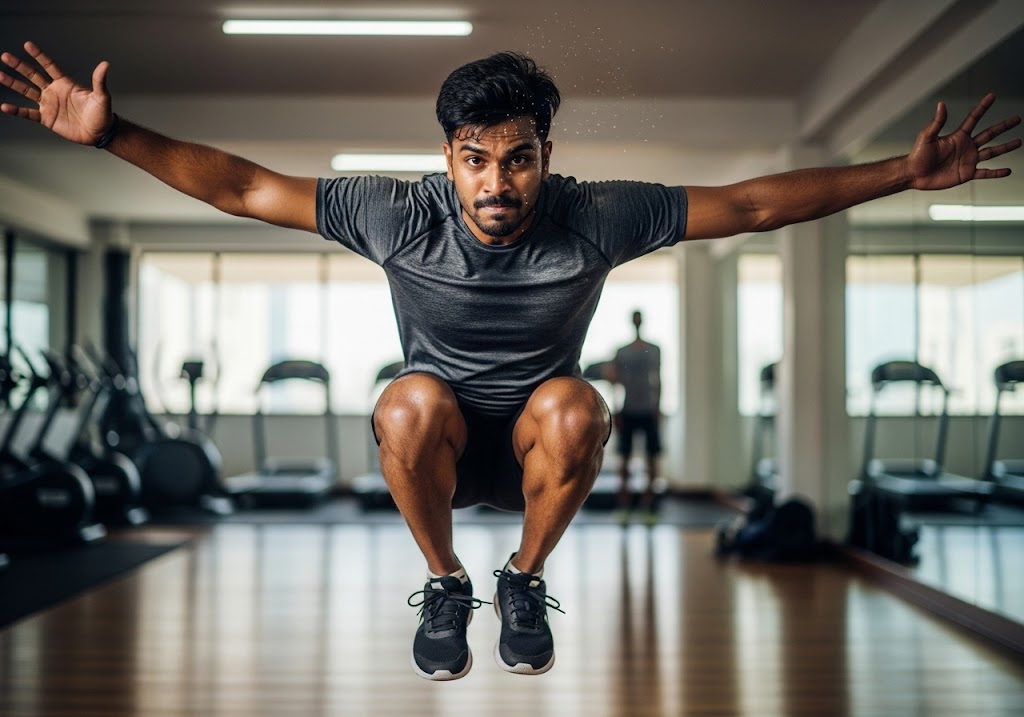
Jump Squats: Nutrition and Recovery for Plyometric Training
Supporting your body’s needs when regularly practicing how to do jump squats requires proper nutrition and recovery protocols. These high-intensity explosive movements place significant demands on your energy systems and musculoskeletal structures, making strategic fueling and recovery essential for optimal performance and adaptation.
Fueling Your Workouts
Proper nutrition supports the high-energy demands when learning how to do jump squats effectively. Plyometric exercises require readily available energy sources and proper hydration to maintain power output and prevent premature fatigue during training sessions.
Consume easily digestible carbohydrates 30-60 minutes before jump squat sessions to fuel explosive movements when you practice how to do jump squats consistently. Post-workout protein intake within 30 minutes supports muscle recovery and adaptation. Stay well-hydrated before, during, and after training to maintain optimal performance and reduce injury risk.
Discover how to burn 300 calories a day to optimize your energy balance for explosive training goals.
Jump Squats: Recovery Protocols
Adequate recovery becomes essential when regularly practicing how to do jump squats due to their high-impact, high-intensity nature. Proper recovery strategies ensure your body adapts positively to training stimuli while preventing overuse injuries and performance decrements.
Incorporate light stretching, foam rolling, and gentle movement on rest days to promote recovery when training how to do jump squats regularly. Ensure adequate sleep (7-9 hours) to support nervous system recovery and adaptation. Consider alternating high-intensity jump squat sessions with lower-intensity movement days to maintain training consistency while allowing proper recovery.
Learn about what is foam rolling to enhance your recovery protocols and maintain optimal muscle function.
Jump Squats: Measuring Progress and Performance
Tracking your development when consistently practicing how to do jump squats provides valuable feedback and motivation for continued improvement. These assessment methods help evaluate explosive power gains, technique refinement, and overall training effectiveness through objective and subjective measurement approaches.
Jump Squats Tracking Improvements
Monitoring your development when learning how to do jump squats provides motivation and helps optimize your training program. Various metrics can track your progress, from basic repetition counts to advanced performance measurements that indicate power development.
Track the number of consecutive repetitions you can perform with perfect form, noting improvements over time when you consistently practice how to do jump squats. Measure your vertical jump height monthly to assess power development. Record training volume and subjective ratings of perceived exertion to monitor your body’s adaptation to the training stimulus.
Explore can hiit build muscle to understand how high-intensity exercises like jump squats contribute to muscle development.
Jump Squats Performance Testing
Periodic assessment when mastering how to do jump squats helps evaluate training effectiveness and guides program adjustments for continued development. These tests provide objective feedback on your explosive power development and overall fitness improvements through consistent plyometric training.
Perform standardized jump squat tests monthly, counting maximum repetitions in 60 seconds while maintaining perfect form when you practice how to do jump squats consistently. Compare your results to previous tests and established fitness norms. Use these assessments to adjust training variables and set realistic goals for continued improvement.
Understanding calisthenics vs weightlifting helps you make informed decisions about incorporating bodyweight movements like jump squats into your training program.
Conclusion
Mastering how to do jump squats properly unlocks significant fitness benefits including explosive power, strength, and cardiovascular endurance. This versatile exercise requires no equipment while delivering maximum results in minimal time, making it perfect for any fitness routine focused on developing athletic performance and functional movement capabilities.
Learn about bodybuilding exercises at home to complement your jump squat training with additional muscle-building movements.
Want to master the calisthenics handstand and take your skills to the next level? Whether you’re a beginner or pushing advanced skills, ISC – Indian School of Calisthenics offers expert guidance to help you master bodyweight training. Visit us at SRPF Ground, NH8, Goregaon (E), Mumbai – 400065. For class schedules, personalized coaching, or more details, call +91 77159 53218. Train smart, move better, and unlock your back strength with ISC.
How to Do Jump Squats? – FAQs
How many jump squats should beginners do?
Beginners should start with 2-3 sets of 5-8 jump squats, focusing on proper form rather than quantity.
Can I do jump squats every day?
No, allow 48 hours between jump squat sessions for proper muscle recovery and injury prevention.
What surface is best for learning how to do jump squats?
Use grass, rubber mats, or gym flooring to reduce joint impact and provide better shock absorption.
How do I prevent knee pain when doing jump squats?
Keep knees aligned with toes, land softly, and ensure proper warm-up before beginning the exercise.
Should I add weights when learning how to do jump squats?
Master bodyweight jump squats first before adding any external resistance to prevent injury risks.
How high should I jump when performing jump squats?
Jump as high as possible while maintaining control and proper landing mechanics throughout the movement.
Can jump squats help me lose weight?
Yes, jump squats burn 8-12 calories per minute due to high-intensity, full-body muscle engagement.
What’s the difference between jump squats and regular squats?
Jump squats add explosive upward movement and plyometric training benefits compared to controlled regular squats.
How long before I see results from doing jump squats?
Most people notice improved power and endurance within 2-4 weeks of consistent, proper jump squat training.
Are jump squats safe for people over 50?
Consult healthcare providers first, as high-impact exercises may not suit everyone depending on joint health.
